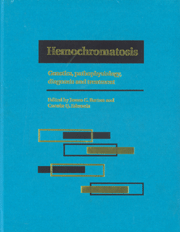Book contents
- Frontmatter
- Contents
- List of contributors
- Foreword
- Part I Introduction to hemochromatosis
- Part II Genetics of hemochromatosis
- 3 Inheritance of hemochromatosis: family studies
- 4 Hemochromatosis: population genetics
- 5 Variation of hemochromatosis prevalence and genotype in national groups
- 6 Human leukocyte antigen (HLA) association and typing in hemochromatosis
- 7 Localization, allelic heterogeneity, and origins of the hemochromatosis gene
- 8 The ancestral haplotype in hemochromatosis
- 9 Evidence for multiple hemochromatosis genes
- Part III Metal absorption and metabolism in hemochromatosis
- Part IV Diagnostic techniques for iron overload
- Part V Complications of iron overload
- Part VI Therapy of hemochromatosis and iron overload
- Part VII Infections and immunity in hemochromatosis
- Part VIII Hemochromatosis heterozygotes
- Part IX Relationship of hemochromatosis to other disorders
- Part X Animal models of hemochromatosis and iron overload
- Part XI Screening for hemochromatosis
- Part XII Hemochromatosis: societal and ethical issues
- Part XIII Final issues
- Index
7 - Localization, allelic heterogeneity, and origins of the hemochromatosis gene
from Part II - Genetics of hemochromatosis
Published online by Cambridge University Press: 05 August 2011
- Frontmatter
- Contents
- List of contributors
- Foreword
- Part I Introduction to hemochromatosis
- Part II Genetics of hemochromatosis
- 3 Inheritance of hemochromatosis: family studies
- 4 Hemochromatosis: population genetics
- 5 Variation of hemochromatosis prevalence and genotype in national groups
- 6 Human leukocyte antigen (HLA) association and typing in hemochromatosis
- 7 Localization, allelic heterogeneity, and origins of the hemochromatosis gene
- 8 The ancestral haplotype in hemochromatosis
- 9 Evidence for multiple hemochromatosis genes
- Part III Metal absorption and metabolism in hemochromatosis
- Part IV Diagnostic techniques for iron overload
- Part V Complications of iron overload
- Part VI Therapy of hemochromatosis and iron overload
- Part VII Infections and immunity in hemochromatosis
- Part VIII Hemochromatosis heterozygotes
- Part IX Relationship of hemochromatosis to other disorders
- Part X Animal models of hemochromatosis and iron overload
- Part XI Screening for hemochromatosis
- Part XII Hemochromatosis: societal and ethical issues
- Part XIII Final issues
- Index
Summary
Introduction
Hemochromatosis is a common autosomal recessive disorder, with a prevalence varying from 1 in 2000 to 1 in 200 in several European populations. It is characterized by excessive iron absorption. Since the body has no effective way of ridding itself of the excess, the resulting iron accumulation eventually leads to organ damage. There is variable age of onset and clinical heterogeneity. Full expression of the disease is usually seen in men during the fourth or fifth decade of life. Symptoms in women generally do not develop until after the menopause, as iron losses associated with menstruation and childbirth often compensate for the enhanced iron absorption. Although hemochromatosis is generally considered a disease of adults, juvenile and childhood onset have been described as well. Neonatal hemochromatosis is a different disease that is unassociated with the inheritance of hemochromatosis.
Association with HLA antigens
Simon et al. described an association between the HLA antigens A3 and B14, and the hemochromatosis gene (HFE), localizing it to the major histocompatibility complex (MHC) on the short arm of chromosome 6 (6p21.3). This association with HLA class I antigens was confirmed by several investigators. Pedigree analysis placed the hemochromatosis gene within 1cM of HLA-A. Beyond the initial studies linking HLA and hemochromatosis, further progress in defining the critical region was slow because of the lack of informative chromosomal translocations and recombinants, and the lack of ordered polymorphic markers telomeric to HLA-A.
- Type
- Chapter
- Information
- HemochromatosisGenetics, Pathophysiology, Diagnosis and Treatment, pp. 75 - 90Publisher: Cambridge University PressPrint publication year: 2000
- 9
- Cited by



